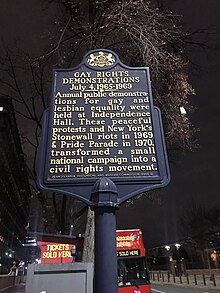Annual Reminder
The Annual Reminders were a series of early
The Reminders were held each year from 1965 through 1969, with the final picket taking place shortly after the June 28
Origin
Activist
Enthused by Rodwell's idea, ECHO put together the first Reminder picket in just over two months. Thirty-nine people attended the first picket, including veteran activists Frank Kameny, Barbara Gittings, and Kay Tobin.[3] Kameny insisted on a strict dress code for participants, including jackets and ties for the men and dresses for the women. Kameny's goal was to represent homosexuals as "presentable and 'employable'".[4]
Picketers carried signs with such slogans as "HOMOSEXUAL BILL OF RIGHTS" and "15 MILLION HOMOSEXUAL AMERICANS ASK FOR EQUALITY, OPPORTUNITY, DIGNITY". The picket ran from 3:30 until 5:00 PM.[3] Press coverage was sparse, although Confidential magazine ran a large feature about the Reminder and other homophile pickets in its October 1965 issue under the headline "Homos On The March".[5]
Final Reminder
The Annual Reminder continued through July 4, 1969. This final Annual Reminder took place less than a week after the June 28 Stonewall riots, in which the patrons of the Stonewall Inn, a gay bar in Greenwich Village, fought against police who raided the bar.[6] Rodwell received several telephone calls threatening him and the other New York participants, but he was able to arrange for police protection for the chartered bus all the way to Philadelphia.[7] About 45 people participated, including the deputy mayor of Philadelphia and his wife.[8]
The dress code was still in effect at the Reminder, but two women from the New York contingent broke from the single-file picket line and held hands.
Following the 1969 Annual Reminder, there was a sense, particularly among the younger and more radical participants, that the time for silent picketing had passed. As Frank Kameny put it, "[P]icketing as such had become questionable. Dissent and dissatisfaction had begun to take new and more emphatic forms in society."
Commemoration


As part of the mural "Pride and Progress" by Ann Northrup (located on the side of the William Way LGBT Community Center at 1315 Spruce Street, Philadelphia) there is a depiction of a man pasting up a poster that itself depicts part of the Annual Reminder picket held in 1966; the poster features Barbara Gittings among others.
The Annual Reminders were commemorated in 2005 by the placement of a Pennsylvania state historical marker by the Pennsylvania Historical and Museum Commission at 6th and Chestnut Streets.[18]
On July 4, 2015, the first Annual Reminder was recreated as part of the celebration of the action's 50th anniversary.[19]
In fiction
The 1995 film Stonewall presents a fictionalized Annual Reminder. However, the film sets the Reminder earlier in the summer, predating the June 28 Stonewall riots.
See also
Notes
- ^ Loughery (1998), p. 270.
- ^ Campbell (2007), p. xviii.
- ^ a b Duberman (1993), p. 113.
- ^ Loughery (1998), p. 271.
- ^ Tobin & Wicker (1972), p. 69.
- ^ Rutledge (1992), pp. 1–2.
- ^ Duberman (1993), p. 209.
- ^ Eisenbach (2006), p. 107.
- ^ Bianco (1999), p. 178.
- ^ Duberman (1993), p. 210.
- ^ Tobin & Wicker (1972), p. 105.
- ^ Sargeant, Fred (1969). "Interview". New Symposium II. Archived from the original on June 14, 2010. Retrieved May 8, 2010 – via David Carter.
- ^ Teal (1971), p. 322.
- ^ Marotta (1981), pp. 164–165.
- ^ Duberman (1993), pp. 226–231.
- ^ Carter (2004), p. 230.
- ^ Eisenbach (2006), p. 108.
- ^ Martinac, Paula. "Annual Reminder Marker". National Trust for Historic Preservation. Archived from the original on August 1, 2011. Retrieved April 3, 2017.
{{cite web}}: CS1 maint: bot: original URL status unknown (link) - ^ Philly celebrates LGBT milestone with anniversary ceremony, block party
References
- Bianco, David (1999). Gay Essentials: Facts For Your Queer Brain. Los Angeles: Alyson Books. ISBN 1-55583-508-2.
- Campbell, J. Louis III (2007). Jack Nichols, Gay Pioneer: 'Have You Heard My Message?'. New York: Harrington Park Press. ISBN 978-1-56023-653-5.
- Carter, David (2004). Stonewall: The Riots That Sparked The Gay Revolution. New York: St. Martin's Press. ISBN 0-312-20025-0.
- Duberman, Martin (1993). Stonewall. New York: Dutton. ISBN 0-452-27206-8.
- Eisenbach, David (2006). Gay Power: An American Revolution. New York: Carroll & Graf Publishers. ISBN 0-7867-1633-9.
- Loughery, John (1998). The Other Side of Silence: Men's Lives and Gay Identities: A Twentieth-Century History. New York: Henry Holt and Company. ISBN 0-8050-3896-5.
- Marotta, Toby (1981). The Politics of Homosexuality. Boston: Houghton Mifflin. ISBN 0-395-31338-4.
- Noland, Alaina (2016). "Reminder Days". The Encyclopedia of Greater Philadelphia. Camden: Rutgers University.
- Rutledge, Leigh (1992). The Gay Decades. New York: Plume. ISBN 0-452-26810-9.
- Stein, Marc (2004). City of Sisterly and Brotherly Loves: Lesbian and Gay Philadelphia, 1947-1972. Chicago: University of Chicago Press. ISBN 1-59213-130-1.
- Teal, Donn (1971). The Gay Militants. New York: Stein and Day. ISBN 0-8128-1373-1.
- Tobin, Kay & Wicker, Randy (1972). The Gay Crusaders. New York: Paperback Library. ISBN 0-446-66691-2.
- ^ "The 5th Annual Reminder Day Protests at Independence Hall". wordpress.com. 29 March 2016. Retrieved 13 March 2018.
